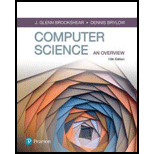
Explanation of Solution
Extent of time taken by an
“Yes”, the problem is considered as tractable even if the best algorithm takes
Reason:
The amount of time taken by an algorithm is based on its complexity. An algorithm is an order or a sequence of unambiguous steps to solve certain problems. These are sets of instructions required to tell a computer to solve a particular problem. The steps are clearly specified without containing any ambiguity in the instructions.
Complexity of an algorithm describes the time required by an algorithm to solve a particular problem for an input of certain size
Trending nowThis is a popular solution!

Chapter 12 Solutions
Computer Science: An Overview (13th Edition) (What's New in Computer Science)
- using r languagearrow_forwardDescribe a business example where referential integrity avoids data problems. specifying in the description of what the problems are and how they can be avoided. thaksarrow_forwardHow do the concepts of balancing and leveling affect the process of creating a data model of a system? thanksarrow_forward
- what is the relationship between a Context Diagram and Diagram 0 in the DFD process. I need to Use an examplearrow_forwardWord Processing The assignment is a newsletter for your friends and family to let them know what’s going on in your life. Your document cannot contain profanity or obscene material—this is a business assignment. The minimum requirements for your newsletter are listed below. It should contain: 2 – 4 pages Your name A title using WordArt with one or more effects applied Articles with formatted titles using a font and color different than that of the article text A section of at least 2 columns Headers and page numbers on all pages except the first page. A bulleted or numbered list A relevant picture or clip art A formatted table Tabs with leaders going to the tabbed items At least one Sidebar Your name as the document author Boldface, italicized, and underlined text A paragraph with justified margins that is shaded and has a border A paragraph with different line spacing than the rest of the document A left, right, or both indented paragraph NOTE: If providing information from outside…arrow_forwardYou are designing a set of firewall rules for server subnet. You have a Web server that constantly gets high volume of traffic from both internal and public clients, a file server that gets moderate use during regular business hours, a VPN appliance used by sales team when they have occasional travels, and an application server for custom apps served on internal network. Describe the firewall rules you would create and the order in which you would place them. Explain why.arrow_forward
- Please original work In the progression from raw data to actionable knowledge, business analysts play a crucial role in transforming and interpreting data to support strategic decision-making. What do you think are the most important skills a business analyst needs to effectively navigate the transition from data to information and then to knowledge? How can organizations ensure that analysts are equipped to extract meaningful insights that drive informed decisions? Share examples or insights from your own experiences or studies. Please cite in text references and add weblinksarrow_forwardResearch enterprise network services commonly performed by Linux servers. Choose 3 and describe their function, as well as why they are typically set up on Linux machines.arrow_forwardThe term color tone refers to the "temperature" of a photo. Question 17Select one: True Falsearrow_forward
- You cannot add 3-dimensional effects to a shape. Question 18Select one: True Falsearrow_forwardWhich gallery shows available shapes for WordArt text? Question 10Select one: a. Transform b. Shape Styles c. Themes d. WordArt Stylesarrow_forwardWhen you press [Shift][Ctrl] while dragging a corner sizing handle on a graphic, the graphic is ____. Question 9Select one: a. resized while keeping the center position fixed and maintaining its proportions b. resized proportionally c. re-positioned diagonally d. resized diagonally while changing proportionallyarrow_forward
 Principles of Information Systems (MindTap Course...Computer ScienceISBN:9781305971776Author:Ralph Stair, George ReynoldsPublisher:Cengage Learning
Principles of Information Systems (MindTap Course...Computer ScienceISBN:9781305971776Author:Ralph Stair, George ReynoldsPublisher:Cengage Learning A+ Guide To It Technical SupportComputer ScienceISBN:9780357108291Author:ANDREWS, Jean.Publisher:Cengage,
A+ Guide To It Technical SupportComputer ScienceISBN:9780357108291Author:ANDREWS, Jean.Publisher:Cengage, Fundamentals of Information SystemsComputer ScienceISBN:9781337097536Author:Ralph Stair, George ReynoldsPublisher:Cengage Learning
Fundamentals of Information SystemsComputer ScienceISBN:9781337097536Author:Ralph Stair, George ReynoldsPublisher:Cengage Learning C++ Programming: From Problem Analysis to Program...Computer ScienceISBN:9781337102087Author:D. S. MalikPublisher:Cengage Learning
C++ Programming: From Problem Analysis to Program...Computer ScienceISBN:9781337102087Author:D. S. MalikPublisher:Cengage Learning Principles of Information Systems (MindTap Course...Computer ScienceISBN:9781285867168Author:Ralph Stair, George ReynoldsPublisher:Cengage Learning
Principles of Information Systems (MindTap Course...Computer ScienceISBN:9781285867168Author:Ralph Stair, George ReynoldsPublisher:Cengage Learning





